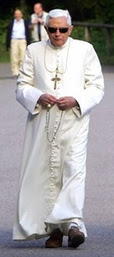I had a rather hair-raising drive to the airport last Thursday, but a good flight. It now strikes me as strange, when I fly Qantas, to find that the cabin crew distribute food and drink gratis; which shews how much I've become used to travel on budget airlines. Arriving at Tullamarine, I discovered how very difficult – and expensive – it is to try and find a car to rent over the very busy Easter holiday break. Suffice it to say I paid out a painfully large sum in order to get transport.
The benefit of arranging my own wheels, though, was great; having navigated successfully along the half-remembered route to St Aloysius from the airport (but, as I remembered too many days too late, forgetting to pay the toll – and thus I daily expect a fine to arrive in the mail), I reached church with plenty of time. Best of all, my friend David Schütz (of Sentire cum Ecclesia) had decided to come along, having read my stated intention on an earlier post here on Psallite Sapienter (so at least this blog does fulfil some useful role). We sat right up the front, especially because, most unexpectedly, we were asked to make up the number of twelve men to have their feet washed.
Solemn Pontifical Mass of the Lord's Supper began at eight. As always, the liturgy was excellently celebrated, with soulful plainchant Ordinary and Proper: how could the heart not melt at the Introit Nos autem, or the Gradual Christus factus est? Come the Maundy, I went forward somewhat embarrassed to have an elderly bishop wash my foot... it reminded me of being in Melbourne a decade or so ago, and in successive years having first Pell, and then Hart do the same to me at the Cathedral.
Greatly to my surprise, Bishop Meeking gave me a coin (20c) as a maundy after washing my foot! I know that the royal practice is to do so; is there something in the Ceremoniale Episcoporum about this?
Having sung only Gregorian till then, the choir repeated Ubi caritas first in plainsong, then according to Durufle's masterful setting.
Meeking gave an excellent sermon, short, doctrinally rich, pointing out how the Mass was instituted by Christ as Sacrament and Sacrifice – how the Mass is not a mere Communion Service, a repetition of the Last Supper considered by itself, but rather of what the Last Supper embodies: the making present (at the Last Supper of what was about to happen on Good Friday, at every Mass since of what was offered then) of Christ's self-oblation consummated on Calvary, so that the Flesh and Blood we receive is the One Sacrifice, the One Victim Who is everlastingly our Priest. For this reason, when we do this as His anamnesis, Christ Himself is present as the Sacrifice offered, a sweet-smelling offering acceptable unto God. (Schütz remarked afterward that this is of course but the Catechism preached; as I responded, the sad truth is how little it is preached.)
David whispered, as we craned our necks to look at His Lordship in the high pulpit, "It's been a long time since I've had to look up for a sermon!"
Again, the choir curiously enough first sang the Offertory in chant, then repeated the same text in what I think was a setting by Palestrina: I wondered if it would have been plus simple et plus uni to sing it but once.
What more to say? The Preface sung was proper to Maundy Thursday, being one of those pro aliquibus locis.
I have always been moved by the proper parts infra Actionis for Holy Thursday: in the Communicantes: “et diem sacratissimum celebrantes, quo DNJC pro nobis est traditus: sed”; in the Hanc igitur: “ob diem, in qua DNJC tradidit discipulis suis Corporis et Sanguinis sui mysteria celebranda”; and in the Qui pridie: “Qui pridie, quam pro nostra omniumque salute pateretur, hoc est, hodie”.
Being Holy Thursday evening, there was no dona nobis pacem in the Agnus Dei, nor prayer for peace, nor sign of peace, on this night of the Judas kiss.
Mass concluded with the usual procession to the altar of repose (the new side altar of Bl John Henry Newman, patron of the Melbourne Latin Mass community), again with both Gregorian chant for the hymn and a polyphonic encore.
After Mass and procession, which took one and a half hours (a very good length, given the special ceremonies of the evening and the fact that a bishop celebrated), there came next the Stripping of the Altars (we monotoned Psalm 21 throughout) and Compline (again monotoned): Confiteor, Misisereatur, Indulgentiam; Pss 4, 90, 133 and the Nunc dimittis (none with Gloria of course); the antiphon Christus factus est; a silent Pater noster; and the Visita qms (with conclusion silent).
The public service concluded at about 10:05pm; I spoke with David outside, then returned to read over John 13-17, Our Lord's last discourse to His disciples (in some liturgical rites, this was done on Holy Thursday, and I like to do the same – particularly as it leads into the Passion to be read on the morrow), and to go to confession. I received good advice from Father: prayer is the sovereign remedy against temptation: pray until temptation goes away. I left Church at about 11pm. Partly in Church, and partly afterward, I read over the penitential psalms, as also was the practice of old time.







